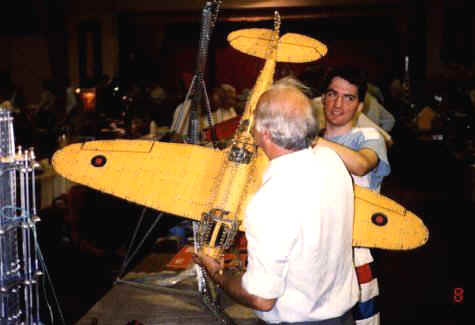|
|
Modeller: Alan Covel, Solihull, Birmingham, UK Notes: The first of this famous family of British fighter aircraft, the Spitfire Mk I began service in RAF squadrons in late summer 1938. It was more manoeuverable and slightly faster than its main rival, the Me 209. In terms of the number of victories for each machine aloft, it was the undisputed winner of the Battle of Britain, during which 19 Spitfire squadrons shot down 1102 enemy planes. Alan's model is built to a scale of 1:8 with a wingspan of 56" and length of 44", and, at exhibitions, was suspended from a framework some 3' off the ground. Two motors powered the airscrew and the raising and lowering of the undercarriage realistically. One of the unique features was the use of black Gunbarrels to form the curve at the front of the wings. |

![]()
Modeller: George Illingworth, Kenilworth, Warwickshire, UK Notes: The prototype Lancaster bomber flew for the first time in January 1941and the production models were ready for action in Spring 1942. Made in great numbers, the Lancaster was in its own way as famous as the Spitfire, and earned a formidable reputation as the "Dam Buster" aircraft. George made this model to mark the 50th Anniversary of the Dambusters raid. After much research it features, retracting undercarriages, moving guns and turrets, opening undercarriage doors and bomb bay fairing, detailed cockpit, working height spotlights and working ailerons, elevators, rudders, flaps and, of course, engines. Built to a scale of 1:12, the model has an 8' 6" wingspan, is 5' 10" long, weighs 86 lb, and is powered by 9 electric motors. The model is still "flying" and hangs above George's desk by the window. |

![]()
Modeller: Paul Joachim, London, UK Notes: Again built to a scale of 1" per foot, the details featured in this model are a fully working swash plate and a remote control mock up of the pilot's seat in miniature, allowing the control of the five rotor blades by variable cyclic and collective pitch to be demonstrated. The tail rotor is also fully demonstrable. The model is powered by an EO20 motor for the rotors and 7 M0 motors for servos to the control elements. |
![]()
To go on to page 3 of the Land Sea Air gallery, please click here.
![]()